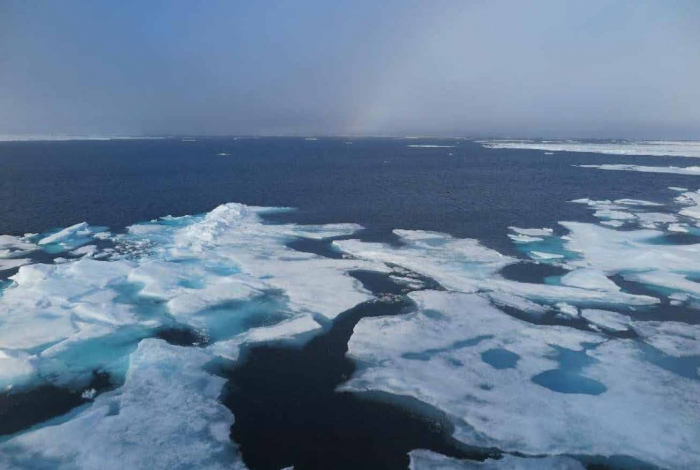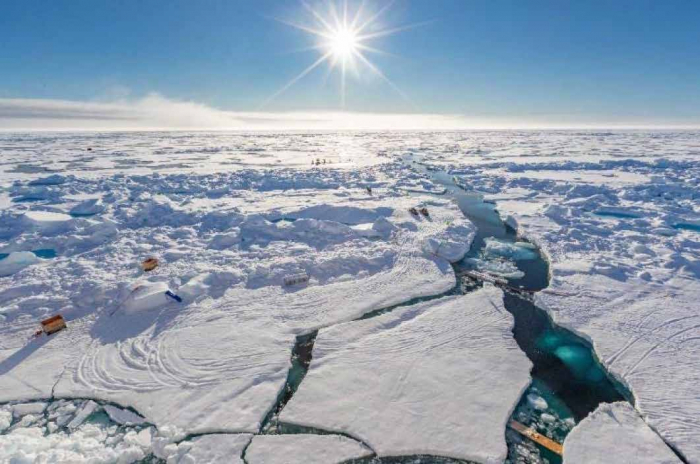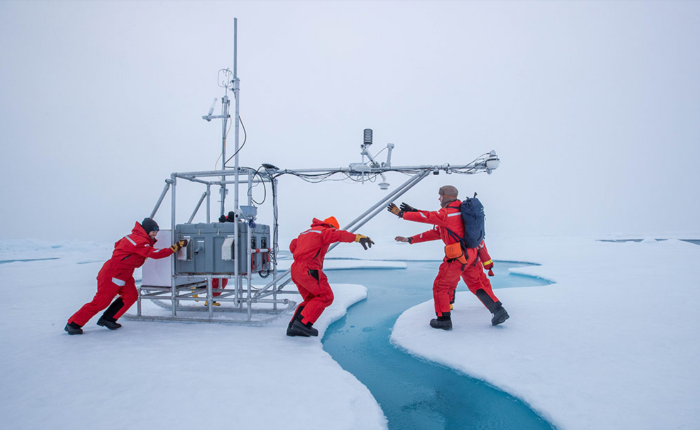After leaving the 'ice fortress' on July 29 the Polarstern motored slowly through the surrounding ice. Over the next few days, researchers and expedition crew from the Polarstern recovered equipment from the Distributed Network surrounding the floe that had been home to the expedition for 300 days and conducted the final crew rotation in the Fram Strait. Then they headed north from the Fram Strait, searching for a place where they could document the new formation of ice during the late-summer freeze. Leaving the ice edge, the crew expected to find newly-forming ice fairly soon. Instead, they were able to move through nearly ice-free seas all the way to the North Pole! In a typical year, transpolar drift pushes ice across the North Pole into the region near Greenland. As they encounter land, chunks of ice accumulate and pile together, like groceries squishing together at the end of the conveyor belt at the store. This means that this region tends to have more concentrated ice cover than other parts of the Arctic Ocean, even during the minimum extent of ice that usually occurs in late summer and early fall. These piles of ice can make it slow going for even the toughest of ice breakers to navigate north from Greenland.

But not this year! It took the Polarstern less than a week to transit from the ice edge to the North Pole. For much of the time, the ship was able to travel through open water. These tracts of open water stretched 180-200 nautical miles north of Greenland, an area typically full of thick, compacted, multi-year ice. Where they did encounter ice, it was mostly thin and porous, showing lots of evidence of melting. North of 88 degrees latitude, the ship started to encounter more ice but was still able to maintain a speed of 5-7 knots. In a press release from the Alfred Wegner Institute, the Polarstern's captain, Thomas Wunderlich, stated "I’ve never seen that so far north... For this region, the current situation is historic. Normally it’s wise to avoid the region north of Greenland, because it’s home to the thicker and older ice, and virtually impassable. But now we’re finding extended stretches of open water, reaching nearly to the Pole.”
These ice conditions north of the Fram Strait were unusual, though after their experience with the rapidly deteriorating home floe, researchers were not particularly surprised. The MOSAiC Expedition has witnessed a year of unusually thin ice, rapidly drifting ice, and loose ice pack. Is this the "New Arctic?" It may be. But even this New Arctic, shorter days lead to colder temperatures and, eventually, refreezing. On August 20th, the Atmosphere Team on the Polarstern documented the first freezing event in months. Freshwater in melt ponds that had formed on the sea ice developed a new layer of ice multiple centimeters thick. The surface skin temperature (temperature at the very surface of the water, ice, or snow) dropped to -2.5 Celsius. Scientists observed that, just before the refreezing happened, a layer of low-lying, warm clouds had broken up. Without this insulating layer, the surface skin temperature rapidly dropped and freezing began.

This refreezing is the final piece of the ice cycle the MOSAiC team hopes to document. That it had started on August 20th made it all the more important for the team to find a suitable new ice floe to moor to. Just one day later, they found it, at 87 degrees 43' North and 104 degrees 30' East. Amazingly, the Polarstern and her first ice floe drifted just 11 nautical miles past this spot in January! ROV (remotely operated vehicle) measurements taken a few days later measured the new ice floe to be about 95-140 centimeters thick (3-5 feet). The team quickly set to work getting a new ice camp set up on the ice, building roads, setting up equipment, deploying sensors, and making observations. Team Ocean quickly deployed a Microstructure Sonde through the first 380 meters (~1100 feet) of ocean. They took advantage of a melt pond that had first formed on top of the sea ice before melting all the way through the ice. This created a large hole where the sensor could be deployed. The Microstructure Sonde makes very very detailed measurements of how layers of water in the ocean interact with each other. In the summer, the dynamics of temperature, salinity, and water movement are really important to understanding how sea ice melts and freezes.
Soon thereafter, two Flux Sleds were situated on the ice floe. Also known as the "met sleds," these are a favorite of mine since I helped to deploy them as part of the distributed network way back in October. It is so cool to know that they survived being chewed on by a polar bear, getting trapped in pressure ridges of ice, and the rapid melting of summer. When we set them on the ice in October, it sounded likely that -- if they made it through the challenges of winter -- it was probable that the heavy, beloved sleds of research equipment would end up sinking to the bottom of the ocean as the ice melted. But they made it! And now the met sleds have been re-situated on the new floe of ice, ready to measure how the atmosphere, ice, and ocean interact as the Arctic shifts from the summer melt season to the fall season of refreezing.

Other interesting measurements include a Kinder Line where researchers are able to measure the albedo. Albedo refers to how much solar radiation something reflects or absorbs. The Kinder Line includes melt ponds and bare ice. Researchers know that as melt ponds form on the ice, the darker water absorbs more solar radiation than the surrounding, highly reflective ice. The more melt ponds there are, the more radiation they absorb and the quicker the ice melts. This forms even larger and more melt ponds, in a positive feedback loop. The measurements from the Kinder Line will help scientists dial in on the albedo differences between shallow, deep, and draining melt ponds and help them to refine their understanding of how sea ice melts in the summer.
On August 25, the ROV was deployed. The ROV is used for mapping conditions and topography on the underside of the ice and making biological observations and measurements. Researchers noticed that visibility was low in the seawater, as it was chock full of algae, phytoplankton, and other organic matter. Despite the low visibility, they did film a seal diving under the ice! In the coming days, net tows for plankton and other biomass measurements will help to quantify life under the ice.
Wow, that's a lot of science! And that's only a few highlights of what the team has been up to on MOSAiC Floe2.0 in the 10 days since they first arrived at the floe. The plan is for them to stay at this floe for approximately 1 more month, until the beginning of October. Then they will say goodbye to the floe, and to the Arctic Ocean, and motor far south to Germany. The expedition is expected to come to a close when they arrive in Bremerhaven, Germany around October 12.
At that point, a different sort of work will commence. Researchers will get to work making sense of the vast and rich array of data, observations, samples, and information gathered throughout this intensive, year-long expedition. What they uncover will make for better weather predictions, sea ice forecasts, and climate change models. All of this is critical for understanding our changing world and how human communities can adapt and sustain the environment we live in. It is a big, important deal.
Education Extension
For middle school and high school students (or adults!), check out the Arctic Feedbacks unit from the CIRES and the University of Boulder. This unit focuses learning about energy budgets and albedo, and includes labs, interacting with real data, and a virtual reality portion about Arctic field work!
And don't miss their unit on Exploring the New and Old Arctic, which focuses on the nature of science and the adventurous researchers and support teams that participate in groundbreaking (icebreaking!) expeditions.
For adults and older students, "Frozen In the Ice" is a free MOOC (massive open online course) offered through Coursera. It includes over 50 videos from MOSAiC scientists and Arctic experts. The course provides a nice balance of breadth and depth in understanding the science of the Arctic and the MOSAiC Expedition.


Comments